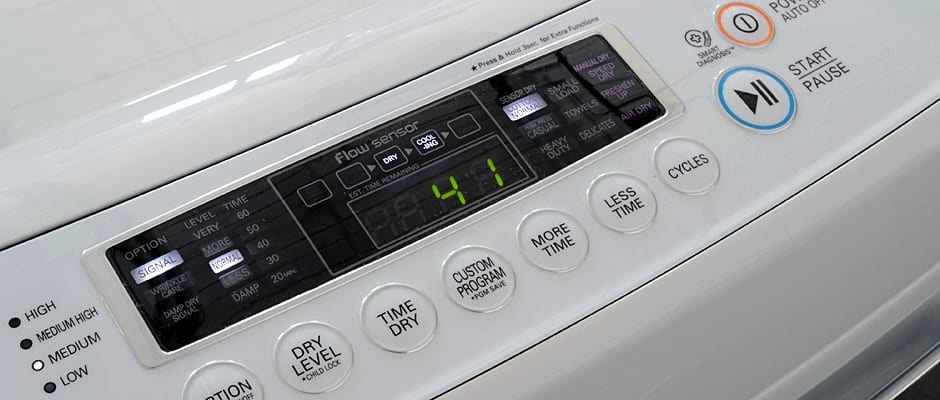Pros
Cons
Introduction
Design & Usability
Small steps toward a truly original design.
While the unusual blending of front and top loader design elements is more striking on its washer counterpart, this LG still manages to make a definitive visual impression. The gently sloping top may not break the boxy mold that seems to limit most of the dryers on the market today, but it certainly cracks it. Fortunately, it's flat enough that your laundry baskets shouldn't slide off when you're not looking. It's better quality than a budget dryer, but it doesn't quite stretch into high end territory.
What's really interesting about this particular model is the location of its control console: the front of the top panel, pointing straight up. It's a surprisingly effective spot, so much so that we wonder why manufacturers haven't utilized this approach more often outside of Asia, where it's fairly common. Placing the controls there negates having to reach over the dryer or crouching down to deal with a panel located right above the door. LG's design isn't perfect—the console itself isn't quite cluttered but comes pretty close and some of the font may be a bit small for certain consumers—but the effective use of backlighting makes it very readable, and we applaud the innovative approach to what is arguably the blandest large appliance in many homes.
{{photo_gallery "Front", "Interior", "Lint Trap", "Controls", "Cycles", "Side", "Back"}}
Performance & Features
A pretty package doesn't guarantee satisfying performance.
Don't be fooled by the interesting design choices: this dryer is decidedly mediocre. Of our four tested cycles, only Normal turned out to get perfect results—and even then, it was thanks to surprisingly high temperatures. On the other hand, the Delicate cycle stayed nice and cool but still left our clothes a bit damp after just over an hour of tumbling. The Speed Dry and Heavy Duty cycles just didn't pull through in any sense, despite exhibiting temperatures that were just as overpowered as what we saw on Normal.
What makes the poor results even more disappointing is the inclusion of a modestly impressive slew of extra features. Ten different cycles—six of which are sensor-based—cover all basic drying needs, plus you have the option to save a customized cycle of your very own. A damp dry signal, wrinkle care option, child lock, four temperature levels, and five dryness settings all make for a relatively comprehensive package. True, it doesn't have a steam hook up, and we have seen models that have a substantially broader range of cycle options, but it's a decent selection compared to other models in this price point.
{{photo_gallery "Cycle List"}}
Conclusion
A good price for a comprehensive machine, if you can get around the performance flaws.
Whether or not you decide to purchase this particular LG dryer depends a lot on what you're looking for. If you want a basic hot box to dry clothes without anything fancy whatsoever, there are definitely simpler models available at a lower or similar price that will do a better job in the end. If you're looking to try a dryer that offers a little more depth of function but don't want to get into the $1,000+ market, however, than perhaps this could catch your eye. Some customers circumvent poor sensor drying by crafting their own cycles, an approach that would go hand in hand with the LG's ability to save a customized setting. With online sale prices as low as $625, the whole package may be good enough to trump this dryer's less-than-perfect performance.
Introduction
As impressed as we were by its interesting design and impressive—for the price—customizability, our reviews always boil down to basic, objective functionality. Design aesthetics and practical usability aside, let us take a closer look at our biggest issues with the performance of the LG DLE1101W.
Normal & Delicate
Decent performance covered in caveats.
The Normal cycle was the only one tested that nailed 100 percent moisture removal. With a cycle that lasts 56 to 57 minutes on average, that's actually quite good. The drawback here is the peak temperature, however. Typically, we like to see Normal cycles peak somewhere between 140 and 145 degrees Fahrenheit. A little warmer is acceptable, but a lot warmer could lead to potential fading or damage to your clothes. The LG peaked at a whopping 159.9 degrees Fahrenheit, definitely too hot for a cycle of average length.
The Delicate setting, on the other hand, offered up perfect temperature performance. Designed to be a cooler cycle, the LG delivered a gentle peak of just 119 degrees. With an average duration of 62 minutes, that is a pair of perfect parameters for completely dry clothing... except that's not what we got when the chime went off. The LG had only removed 93 percent of excess moisture from our test load, a result that comes close to being acceptable. After all, delicate garments are often hung up to finish drying afterwards, and a little moisture in the fabric helps with that... but 93 percent is just a bit too damp to earn genuine praise.
{{photo_gallery "Normal Test", "Delicate Test"}}
Quick Dry & Bulky
Not happening.
Speed Dry only lived up to half of its name, and we'll give you a hint as to which: it's not the second half. At 25 minutes, this cycle definitely whips through laundry, churning out temperatures that were clocked as getting up to 164.9 degrees Fahrenheit. In short bursts, that kind of heat won't do as much damage as it would on, say, a Normal cycle running for almost an hour. Unfortunately, a short heat bomb like that didn't quite get the job done: after the cycle concluded, our clothes had only lost 74 percent of their excess moisture.
The Heavy Duty cycle was no better, and we suspect that the sensor in this dryer couldn't quite handle our large, bulky test comforter. It was the hottest cycle we tested, peaking at 168.8 degrees Fahrenheit, but it shut down after only 37 minutes. After wrestling the damp comforter out of the barrel of the dryer, our scale showed that—much like the Speed Dry—it had only lost 73 percent of the excess moisture.
{{photo_gallery "Quick Dry Test", "Bulky Test"}}
Meet the tester
Matthew is a native of Brockton, Mass., and a graduate of Northeastern University, where he earned a degree in English and Theatre. He has also studied at the Gaiety School of Acting in Dublin, Ireland, and spends time pursuing a performance career in the greater Boston and Cambridge area.
Checking our work.
Our team is here to help you buy the best stuff and love what you own. Our writers, editors, and experts obsess over the products we cover to make sure you're confident and satisfied. Have a different opinion about something we recommend? Email us and we'll compare notes.
Shoot us an email

